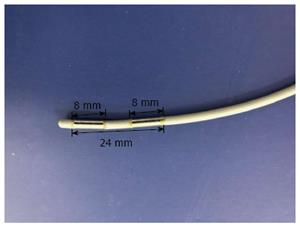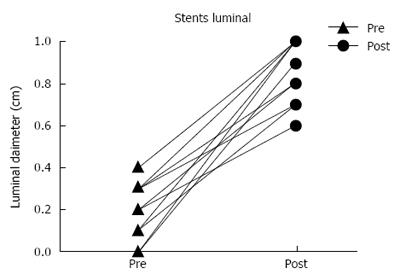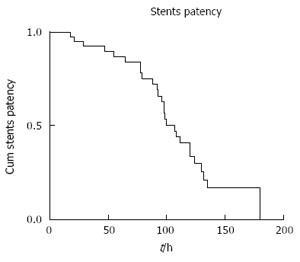Copyright
©The Author(s) 2017.
World J Gastroenterol. Mar 14, 2017; 23(10): 1851-1856
Published online Mar 14, 2017. doi: 10.3748/wjg.v23.i10.1851
Published online Mar 14, 2017. doi: 10.3748/wjg.v23.i10.1851
Figure 1 The Habib EndoHPB bipolar radiofrequency ablation catheter with two bare metal electrodes 8 mm apart and the catheter head located 5 mm from the distal electrode.
Figure 2 Images for a 53-year-old female with carcinoma of the pancreatic head and a biliary stent implanted to treat obstructive jaundice 3.
5 mo prior to this study for obstructive jaundice. An enhanced computed tomography (CT) scan showing bile duct obstruction (A); CT coronal reconstruction clearly showing stent obstruction (B); cholangiography revealing the complete obstruction of the biliary stent (C), the intraductal radiofrequency (RF) catheter in the position of obstruction (D), and internal and external drainage tube after RF (E); angiography indicating stent patency after procedure (F).
Figure 3 Stent patency trends after procedure.
Figure 4 Luminal diameters before and after the procedure.
- Citation: Xia N, Gong J, Lu J, Chen ZJ, Zhang LY, Wang ZM. Percutaneous intraductal radiofrequency ablation for treatment of biliary stent occlusion: A preliminary result. World J Gastroenterol 2017; 23(10): 1851-1856
- URL: https://www.wjgnet.com/1007-9327/full/v23/i10/1851.htm
- DOI: https://dx.doi.org/10.3748/wjg.v23.i10.1851












